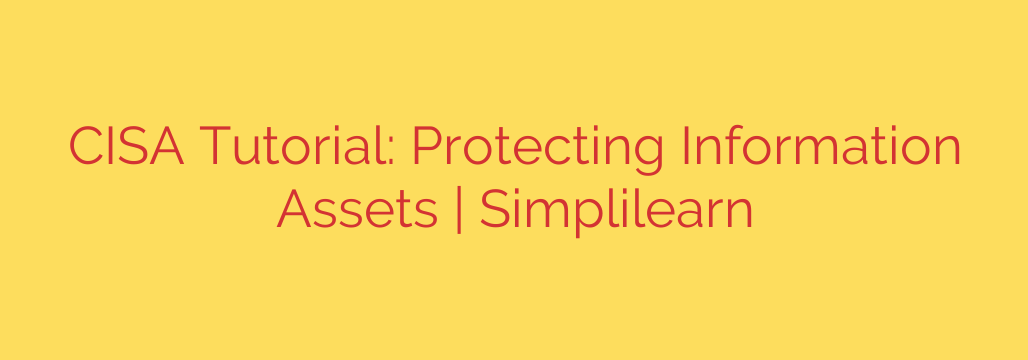
A Comprehensive Guide to Protecting Your Information Assets
In today’s digital economy, your organization’s most valuable resources are no longer just physical. Your information assets—the data, systems, and infrastructure that power your business—are the true crown jewels. Protecting these assets isn’t just an IT task; it’s a fundamental business imperative crucial for maintaining trust, ensuring compliance, and securing your competitive edge.
Failing to adequately protect information can lead to devastating consequences, including significant financial loss, irreparable reputational damage, and severe legal penalties. This guide provides a clear framework for understanding and safeguarding your critical information assets.
What Exactly Are Information Assets?
Before you can protect your assets, you must know what they are. Information assets encompass more than just files in a database. They are the complete set of components that store, process, and transmit information.
These typically fall into four main categories:
- Data: This is the core asset. It includes customer information, financial records, intellectual property, employee data, and strategic plans.
- Hardware: The physical devices where data is stored and processed, such as servers, computers, hard drives, and networking equipment.
- Software: The applications and operating systems that make the hardware useful, including proprietary software, off-the-shelf applications, and system utilities.
- Personnel: The people who have access to and knowledge of your information systems are also a critical asset and a potential point of vulnerability.
The Foundation of Security: The CIA Triad
A robust information security strategy is built upon a time-tested framework known as the CIA Triad. This model focuses on three core principles that must be balanced to achieve comprehensive protection.
1. Confidentiality
Confidentiality ensures that sensitive information is not disclosed to unauthorized individuals, entities, or processes. It’s about restricting access to those who have a legitimate need to know.
- Why it matters: Prevents the theft of trade secrets, protects customer privacy (PII), and ensures internal strategic discussions remain private.
- How to achieve it: Implement strong access controls, use encryption for data at rest and in transit, and enforce clear data handling policies.
2. Integrity
Integrity involves maintaining the consistency, accuracy, and trustworthiness of data over its entire lifecycle. Data must not be changed in an unauthorized or undetected manner.
- Why it matters: Guarantees that financial records are accurate, source code hasn’t been maliciously altered, and business reports are reliable.
- How to achieve it: Use file integrity monitoring tools, hashing algorithms, version control systems, and strict access permissions to prevent unauthorized modifications.
3. Availability
Availability ensures that information and systems are accessible and usable upon demand by authorized users. Security controls must not get in the way of legitimate business operations.
- Why it matters: Ensures your website remains online for customers, employees can access the tools they need to work, and critical operations continue without disruption.
- How to achieve it: Implement hardware redundancy (like RAID), perform regular data backups, create disaster recovery plans, and protect against Denial-of-Service (DoS) attacks.
Building Your Information Security Program: Key Pillars
A successful security program is proactive, not reactive. It involves creating a structured framework to manage risk and implement layers of defense.
Conduct a Thorough Risk Assessment
You can’t protect against threats you don’t know exist. A risk assessment is the process of identifying potential threats to your information assets, evaluating their likelihood and potential impact, and deciding how to respond. This allows you to prioritize your security investments where they matter most.
Implement Strong Access Controls
Control who can access what. This applies to both physical and digital assets. A core concept here is the Principle of Least Privilege, which states that users should only be given the minimum levels of access—or permissions—necessary to perform their job functions.
Classify Your Data
Not all data is created equal. Data classification is the process of categorizing data based on its sensitivity and the impact its disclosure would have. Common levels include:
- Public: Information cleared for public release.
- Internal: Information for employees but not for public consumption.
- Confidential: Sensitive data that could cause moderate damage if disclosed.
- Restricted: Highly sensitive data that would cause severe damage (e.g., trade secrets, government-classified information).
Classification dictates the level of security controls required for each data type.
Develop an Incident Response Plan
Despite your best efforts, security incidents can still happen. An incident response plan is a detailed guide that outlines exactly what to do when a security breach occurs. It defines roles, responsibilities, and communication strategies to minimize damage, reduce recovery time, and ensure business continuity.
Essential Security Controls for Every Business
While your specific needs will vary, several technical and procedural controls are universally essential for protecting information assets.
- Encryption: Scramble data so it is unreadable without the proper key. Encrypt sensitive data both at rest (on a hard drive) and in transit (over a network).
- Firewalls and Network Security: Act as a barrier between your trusted internal network and untrusted external networks like the internet, filtering malicious traffic.
- Regular Backups: Create copies of your critical data and test your ability to restore them. This is your ultimate safety net against ransomware, hardware failure, or accidental deletion.
- Security Awareness Training: Your employees are your first line of defense. Regular training on topics like phishing, password security, and social engineering can drastically reduce human error.
- Antivirus and Anti-Malware Software: Install and regularly update software that detects and removes malicious code from your systems.
- Physical Security: Don’t forget to protect your hardware. Secure server rooms, use locks, and implement surveillance to prevent physical theft or tampering.
Protecting your information assets is a continuous process of assessment, implementation, and improvement. By adopting a layered security strategy based on these foundational principles, your organization can effectively mitigate risks and safeguard its most critical resources for long-term success.
Source: https://www.simplilearn.com/protection-of-information-assets-cisa-tutorial-video








